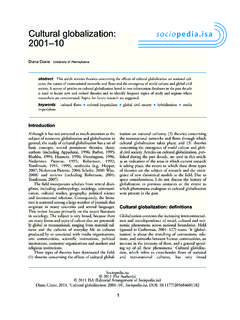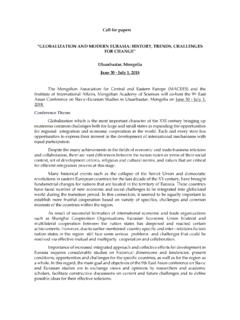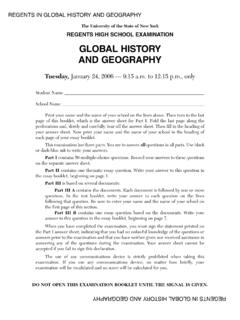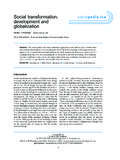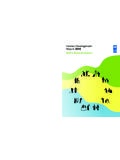Transcription of Development: Development: aaaan Analysis of …
1 Available online at BAR, Curitiba, v. 5, n. 2, art. 2, p. 104-124, 2008 development : development : development : development : aaaan Analysis of Concepts, n Analysis of Concepts, n Analysis of Concepts, n Analysis of Concepts, Measurement and IndicatorsMeasurement and IndicatorsMeasurement and IndicatorsMeasurement and Indicators Jair Soares Jr. * E-mail address: Escola de Administra o, Universidade Federal da Bahia Salvador, BA, Brazil. Rog rio H. Quintella E-mail address: Escola de Administra o, Universidade Federal da Bahia Salvador, BA, Brazil. AAAABSTRACTBSTRACTBSTRACTBSTRACT This paper presents the result of a comprehensive Analysis of the main forms of development measurement. Recognizing the level of complexity that the subject involves, aspects related to interpretations and dominant ideologies in development /growth concepts are shown initially.
2 The second part of this work constitutes a critical Analysis of forty-three of the most well-known national and international indicators used to measure this phenomenon. It is imagined that this Analysis can show the state of the art for constructing development indicators. The development process covers a complexity of relationships. Its Analysis , therefore, cannot be restricted only to the economic dimension because, as a rule, the question is presented both in the media and a considerable part of specialized literature. Emphasis on this dimension has historic origins, which have already shown the fragility of this approach. Key words: development ; development indicators; index; well-being. Received 12 February 2008; received in revised form 28 April 2008.
3 Copyright 2008 Brazilian Administration Review. All rights reserved, including rights for translation. Parts of this work may be quoted without prior knowledge on the condition that the source is identified. * Corresponding author: Jair Soares Jr. N cleo de P s-Gradua o em Administra o (NPGA), Universidade Federal da Bahia (UFBA), Av. Reitor Miguel Calmon, s/n, 3 andar, Canela, Salvador/BA, 41110-903, Brazil. development : an Analysis of Concepts, Measurement and Indicators BAR, Curitiba, v. 5, n. 2, art. 2, p. 104-124, 2008 105 HHHHISTORIC ISTORIC ISTORIC ISTORIC DDDDETERMINANTS OF ETERMINANTS OF ETERMINANTS OF ETERMINANTS OF DDDDEVELOPMENTEVELOPMENTEVELOPMENTEVELOP MENT:::: FROM THE FROM THE FROM THE FROM THE 17171717 THTHTHTH TO TO TO TO 19191919 THTHTHTH CCCCENTURYENTURYENTURYENTURY The concept of development is almost as old as civilization.
4 Its extensive use in western societies from Greco-Roman civilizations to the late 19th century as a generic construct that designates the most varied aspects related to humanity s well-being, however, made the concept come closer to that of a doctrine. For this present study s purposes, a temporal cut was chosen from 17th century illuminist ideas and its metamorphoses until current times. At the end of that century, the predominant idea of development was dependent on natural and positive phenomena, with its expansion only contained by conscience of limit(1). Following a long dispute between those called the Modern and Ancient, ending with victory by the Modern, Leibniz (1646-1716) inaugurated the concept of infinite progress.
5 Other modern thinkers such as Condorcet, Kant, Hegel and Marx in turn conceived and interpreted progress in a distinct manner from that resulting from the idea of conscience of limit or, in other words, are aligned with the potentially infinite concept of progress. In these authors works, it is also possible to note a certain proximity with Augustinian thinking, of conceiving history as a totality, a firm march of civilization, a continual, albeit inconstant and non-linear process, in the direction of a common well-being. In Rist s words: a constant evolution, based on the belief of human perfectibility and motivated by the incessant search for well-being (Rist, 2001, p. 70). In the mid 18th century, radically opposing the Rousseaunian vision of the good savage(2), Buffon (1707-1788) defended the idea that there is a general prototype for each species in nature and that this is perfected because of the climate and habits of the society in which it is inserted.
6 In his work Natural History, the author defends the idea that civilization will arrive at the European and affirms: Because of their superiority, civilized people are responsible for the coming world (Buffon as cited in Duchet, 1984, p. 54). In this way, Buffon almost gives the force of law to what he perceives as a historic reality. Also in the 18th century, the Marquis of Condorcet (1743-1794), launched the bases of thinking that would predominate in the second half of the 20th century, in defending the idea that Europeans would end up respecting the independence of their ex-colonies and, then, should contribute to them through civilizing their people(3) (Rist, 2001, p. 68). Another paradigm of development , however, had already reached its peak in the 19th century, under the form of Social Evolutionism.
7 The term development , in this new paradigm, prevailed on concepts such as modernization or liberation. Such predominance seems to result from the need for a broader concept to represent the multiple dimensions necessary for humanity s well-being. An apparent alignment of modernity theories can now be highlighted in the sense of perceiving social groups as a unique species and therefore presenting similar development paths. However, recurrent analogy with the natural development processes does not explain and is not even able to adequately deal with the cultural multiplicity present in societies, particularly in the 20th and 21st centuries, as will be discussed later on in this paper. 20202020TH TH TH TH CCCCENTURY ENTURY ENTURY ENTURY DDDDEVELOPMENTEVELOPMENTEVELOPMENTEVELOP MENT:::: TTTTHE HE HE HE PPPPERSPECTIVE OF ERSPECTIVE OF ERSPECTIVE OF ERSPECTIVE OF IIIINTERNATIONAL NTERNATIONAL NTERNATIONAL NTERNATIONAL AAAAGENCIEGENCIEGENCIEGENCIESSSS The growing diffusion of development concepts and policies permits the last decades to be nominated here as the era of development .
8 The origin of this era, in which we supposedly still live, can be located at the end of the first half of the 20th century, possibly in North American President Harry S Truman s international policy, when he decided to highlight the importance of extending the technical help offered to some Latin American and other less-favoured nations: Jair Soares Jr., Rog rio H. Quintella BAR, Curitiba, v. 5, n. 2, art. 2, p. 104-124, 2008 106I believe that we should make available to peace loving peoples the benefits of our store of technical knowledge in order to help them realize their aspirations for a better life. And, in cooperation with other nations, we should foster capital investment in areas needing development (Truman, 1949). The Marquis of Condocert s aforementioned ideas can therefore be compared with a new international situation.
9 1960 is considered to be the year of decolonization, a process, which until then had been legitimized purely as a generous agreement aiming to offer opportunity to societies that were considered the slowest to advance on the path of civilization. Several countries became independent from that moment and the supposed decolonization process crossed the world. This even changed the relationship of forces in the United Nations plenary session and apparently placed the problems of world inequality and the need for development in what was then called the Third World at a higher level. The development question took on new shapes and slants a little later in December, 1964 with the creation of the United Nations Conference on Trade and development [UNCTAD].
10 This organization was created with the objective of attempting to bridge the gap, which was not covered by the organizations that appeared following the Second World War. Another international milestone in development question took place in 1968, with the creation of the Rome Club. This brought together professionals from various areas and different countries to form a free association of scientists, technocrats and politicians, whose objective was to reflect on and seek solutions to various world problems. This new forum published a report entitled Growth Limits in 1972, in which it recognizes the finitude of natural resources and the seriousness of the problems that were already devastating the environment and jeopardizing human survival on Earth.










